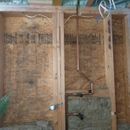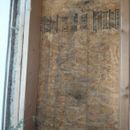Moldy OSB Sheathing Behind Mineral Wool Batt Insulation
This is a new build, homeowners moved in in 2021. Canada Zone 6.
Wall assembly from outside in
Fibre Cement
1×4 furring strips
Two layers 2_1/4″ silverboard graphite EPS – seams taped and staggered ea. layer total 4_1/2″
Tyvek wrap, taped seams
OSB 7/16″ taped seams
2×6 framing
Roxul filled cavity
1/2″ drywall w/ Benjamin Moore Ultra Spec Interior Vapour Barrier Sealer + Latex paint
In the master bathroom, the shower area is not covered (it will be Kerdi soon) with anything and just has roxul visible, studs, etc. Home owner was having issues getting Kerdi as well as the material for the steam shower that will be installed in this area so it was left unfinished. Today he was working in here and removed roxul to run water lines to discover some mold behind the roxul insulation against the OSB. The sheathing is also slightly damp feeling.
To clarify, the master bathroom is fully finished drywall w/ vapour barrier primer. EXCEPT for the area that is shown in the pictures. There has never been any drywall or wall finishing applied to this surface. It was simply left as roxul insulation and bare studs. The bathroom is used often, hot baths are taken weekly in this area, I cannot guarantee that the home owners are running the HRV the entire time the bath is running/used.
Weather lately has been very cold (-30c) but now warm and wet outside. Today it is +2c with rain and an RH indoor of about 50%. The master bathroom is used for bathing with the tub just off to the left in the image, HRV runs normally.
I am concerned about the wall assembly.
A couple of photos attached.
GBA Detail Library
A collection of one thousand construction details organized by climate and house part











Replies
Your exterior insulation is about R-22 and the mineral wool in the framing cavity is about R-23. This is a good example of why class 3 vapor retarders are required by the IRC, even when there is a lot of exterior insulation. Humid, indoor air can still reach the sheathing, which in your case will be about halfway between the indoor temperature and the outdoor temperature.
At -30C (-22F) outside and let's say 20°C indoors (68°), the sheathing will be somewhere around -5°C (23°F). The 68°F air would have to be under 18% relative humidity to NOT condense on the sheathing.
At more comfortable and healthy interior conditions of 40% RH and 68°F, the sheathing would need to be above about 45°F to avoid condensation. For that to happen you would need a higher ratio of exterior insulation to interior insulation. Or, an easier approach is to have the vapor retarder slow moisture movement so the sheathing can dry to the exterior more quickly than it is being loaded with moisture from the interior. In other words, once you add the vapor retarder, the problem should go away.
Hi Michael,
Thank you for your in depth response. It is much appreciated.